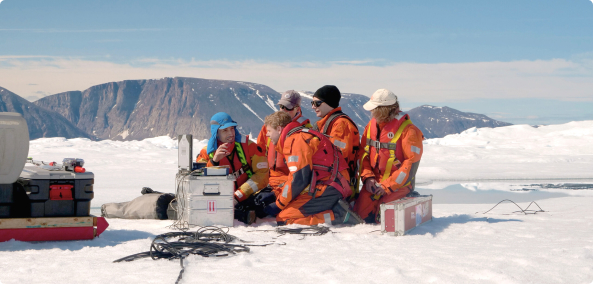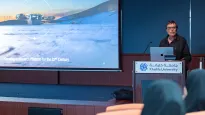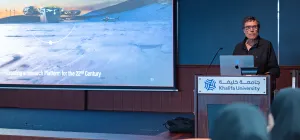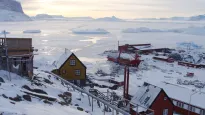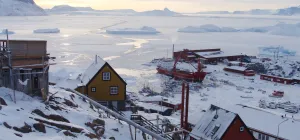In Search for Million-Year-Old Ice, Belgian and International Scientists Return from Antarctica with First Clues
Belgian and international scientists from the Vrije Universiteit Brussel (VUB) and the Université Libre de Bruxelles (ULB) have returned from Antarctica with samples and data that could help them determine where to find million-year old ice, which in turn can provide information about Earth’s climate in the past.
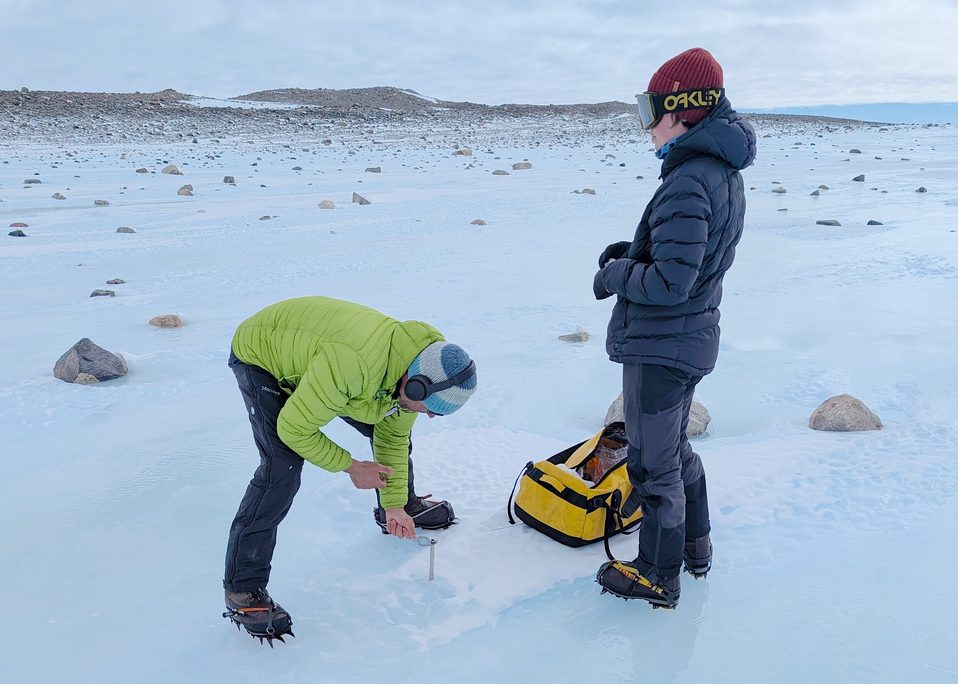
Belgian and international scientists from the Vrije Universiteit Brussel (VUB) and the Université Libre de Bruxelles (ULB) have returned from Antarctica with samples and data that could help them determine where to find million-year old ice, which in turn can provide information about Earth’s climate in the past.
Financed by the Belgian Federal Science Policy (BELSPO) and the Université Libre de Bruxelles’ QUOI project, with strong logistical support from the International Polar Foundation (IPF), which is mandated to manage the zero-emission Princess Elisabeth Antarctica research station by the Belgian Polar Secretariat, the team of scientists from the FROID project (“Finding the world’s oldest ice record around the Princess Elisabeth Station”) spent several weeks on a field campaign in the Nils Larsen Blue Ice Field near the Sør Rondane Mountains in December and early January.
The field team consisted of four scientists - Maaike Izeboud (VUB), Etienne Legrain (ULB/VUB), Veronica Tollenaar (VUB), and Harry Zekollari (VUB) - who were supported by IPF field guide François Pallandre and IPF technician Nicolas Grosrenaud. They drilled shallow ice cores to date the surface age of the ice, took surface ice samples, planted stakes in the ice to see how much ice is being lost at the surface, and collected radar data to evaluate ice thickness. The data they obtain from all of this work will help the scientists figure out where the ice is the oldest, and therefore where to drill an ice core with the goal of retrieving million-year-old ice.
“Antarctica is covered by an ice sheet in most places, and the further down into the ice sheet you go, the older the ice is,” explained Prof. Harry Zekollari. “Air bubbles trapped in the ice, which formed as snow fell on the surface and turned into ice over time, can tell us how the composition of the atmosphere varied in the past and therefore what the climate was like going back hundreds of thousands, or even a million years.”
Some of the oldest ice in Antarctica lies at the bottom of the Antarctic Ice Sheet, where the ice meets the bedrock of the Antarctic continent. Previous international scientific expeditions to drill deep ice cores to find the oldest ice have been able to go back hundreds of thousands of years in climate history. The most well-known of these was the EPICA project (European Project for Ice Coring in Antarctica), which was able to retrieve an ice core going back 800,000 years at Dome C, one of the highest points on the Antarctic Ice Sheet. Recently, in a follow-up deep drilling project (Beyond EPICA), ice older than 1,200,000 years was recovered. However, many of these ice coring projects drilled straight down several kilometres into the ice sheet to retrieve the oldest ice. This method is technically difficult, expensive, and time-consuming.
“The FROID project takes a different approach to finding very old ice without having to drill kilometres-deep ice cores,” explained Dr. Veronica Tollenaar. "It takes advantage of the location of blue ice areas on the continent. The Antarctic Ice Sheet slowly flows from the centre of the continent to its coasts due to gravity. As the ice approaches mountains, in blue ice areas, the ice at the bottom of the ice sheet is pushed up closer to the surface, making the oldest ice easier to access.”
Altogether this season the research team collected 15 shallow ice cores, more than 1000 surface ice samples, and did 200 km of radar transects. The ice samples are currently being shipped back to Belgium, where they will be analysed in the labs of the participating universities.
The field camp for the FROID project was located in the Nils Larsen Blue Ice Field 2300 metres above sea level, not far from the Sør Rondane Mountains, about 50-60 km from the Princess Elisabeth station.
The team encountered an interesting phenomenon during their field work.
“One thing we came across during our time up at the field was a liquid surface lake, which is very rare to find in Antarctica, especially at the high altitude where we were,” Dr. Maaike Izeboud stated. “However, there were several warm days in December with high temperatures, so this lake may have formed due to surface melt. We need to investigate this further by modelling the surface mass balance to see how exceptional the formation of a surface lake at that altitude might be.”
They also had some unexpected visitors right before the new year.
“On New Year’s Eve, several south polar skuas, which are large sea birds that typically live near the coast, paid us a visit,” Dr. Etienne Legrain recounted. “While Henri Robert, the IPF Science Liaison Officer who is also a biologist, said it’s normal that skuas occasionally fly several hundreds of kilometres to breed in small numbers in the Sør Rondane Mountains, we were nonetheless amazed to see a form of life after so many days in the field!”
The FROID project plans to return to Antarctica for a second field campaign during the 2026-27 research season.
Scientist contacts
François Fripiat – FROID and QUOI project lead (ULB, francois.fripiat@ulb.be)
Maaike Izeboud – scientist on the field (VUB, maaike.izeboud@vub.be)
Etienne Legrain – scientist on the field (ULB/VUB, etienne.legrain@ulb.be)
Veronica Tollenaar – scientist on the field and FROID project co-lead (VUB, veronica.tollenaar@vub.be)
Harry Zekollari – scientists on the field and FROID project co-lead (VUB, harry.zekollari@vub.be)
IPF Press contact
Joseph Cheek (e-mail: jcheek@polarfoundation.org)
Please contact us for photos and videos.
About the International Polar Foundation (IPF)
The IPF is a private foundation with a public service mandate, created in 2002 by Alain Hubert. Its remit is to support international polar scientific research. The IPF was also behind the creation of the Princess Elisabeth Antarctica station, which was officially opened in 2009 as the first and, to date, only zero-emission station, with a view to maintaining a Belgian presence in Antarctica and pursuing its ambition in service of citizens facing climate and environmental challenges. Every year, the Princess Elisabeth Antarctica station hosts numerous scientists of all nationalities.
————————-
Nederlandstalige versie
Brussel, 27 januari
Op zoek naar ijs van een miljoen jaar oud : Belgische wetenschappers keren terug uit Antarctica met eerste aanwijzingen
Wetenschappers van de Vrije Universiteit Brussel (VUB) en de Université Libre de Bruxelles (ULB) zijn teruggekeerd uit Antarctica met stalen en gegevens die hen kunnen helpen bepalen waar ijs te vinden is van naar schatting een miljoen jaar oud. Dat ijs kan op zijn beurt informatie verschaffen over het klimaat op aarde in het verleden.
Hun expeditie werd gefinancierd door het Belgisch Federaal Wetenschapsbeleid (BELSPO) en het QUOI-project van de Université Libre de Bruxelles, en kreeg sterke logistieke steun van de International Polar Foundation (IPF), die in opdracht van het Belgisch Poolsecretariaat het emissievrije onderzoeksstation Prinses Elisabeth Antarctica beheert.
Het team van wetenschappers van het FROID-project ("Finding the world’s oldest ice record around the Princess Elisabeth Station") bracht in december en begin januari enkele weken door in het Nils Larsen Blue Ice Field ,nabij de Sør Rondane-bergen, voor een veldcampagne. Vier wetenschappers – Maaike Izeboud (VUB), Etienne Legrain (ULB/VUB), Veronica Tollenaar (VUB) en Harry Zekollari (VUB) – trokken de bergen. Ze werden ondersteund door veldgids François Pallandre en technicus Nicolas Grosrenaud van de International Polar Foundation (IPF). Ze boorden ondiepe ijskernen om de oppervlakteleeftijd van het ijs te bepalen, namen oppervlakte-ijsmonsters, plaatsten staken in het ijs om te meten hoeveel ijs aan de oppervlakte verloren gaat en verzamelden radargegevens om de ijsdikte te evalueren. De gegevens uit het onderzoek zullen de wetenschappers helpen vast te stellen waar ze het oudste ijs kunnen aantreffen en waar ze een boring kunnen uitvoeren om ijs van een miljoen jaar oud te vinden.
"Antarctica is op de meeste plaatsen bedekt door een ijskap, en hoe dieper je in de ijskap gaat, hoe ouder het ijs is," legt prof. Harry Zekollari uit. "Luchtbellen die in het ijs zijn opgesloten – gevormd toen sneeuw op het oppervlak viel en in de loop van de tijd in ijs veranderde – kunnen ons vertellen hoe de samenstelling van de atmosfeer in het verleden varieerde en dus hoe het klimaat er honderden duizenden, of zelfs een miljoen jaar geleden uitzag."
Een deel van het oudste ijs in Antarctica bevindt zich op de bodem van de Antarctische ijskap, waar het de gesteenten van het Antarctische continent raakt. Eerdere internationale wetenschappelijke expedities, om diepe ijskernen te boren en het oudste ijs te vinden, hebben klimaatgegevens van enkele honderdduizenden jaren kunnen opgeleverd. Wetenschappers konden voor het EPICA-project (European Project for Ice Coring in Antarctica), een ijskern ophalen die 800.000 jaar terugging nabij Dome C, een van de hoogste punten van de Antarctische ijskap. Onlangs werd in een vervolgproject (Beyond EPICA) zelfs ijs gevonden dat ouder is dan 1.200.000 jaar. Veel van die projecten boren echter verticaal tot enkele kilometers diep in de ijskap, een technisch complexe, dure en tijdrovende methode.
"Met het FROID-project hanteren we een andere aanpak om zeer oud ijs te vinden, zonder dat we kilometers diepe ijskernen hoeven te boren," zegt Dr. Veronica Tollenaar. "We maken gebruik van blauwe ijsgebieden op het continent. De Antarctische ijskap stroomt door zwaartekracht langzaam van het centrum van het continent naar de kust. Als het ijs de bergen nadert, wordt in blauwe ijsgebieden het onderste ijs van de ijskap naar het oppervlak geduwd, waardoor het oudste ijs gemakkelijker toegankelijk wordt."
Tijdens de expeditie verzamelde het team alles samen vijftien ondiepe ijskernen, meer dan duizend oppervlakte-ijsmonsters en voerde het 200 km aan radartransecten uit. De ijsmonsters worden momenteel naar België verscheept, waar ze in de laboratoria van de betrokken universiteiten zullen worden geanalyseerd.
Het veldkamp van het FROID-project bevond zich in het Nils Larsen Blue Ice Field, op 2300 meter boven zeeniveau, niet ver van de Sør Rondane-bergen en ongeveer 50-60 km van het Prinses Elisabeth-station.
Het team stootte tijdens het veldwerk op een niet bevroren en dus vloeibaar oppervlaktemeer. "Dat is in Antarctica erg zeldzaam, vooral op de hoogte waar we ons bevonden," verklaart dr. Maaike Izeboud. "Echter, in december waren er enkele warme dagen met hoge temperaturen. Waarschijnlijk is het meer ontstaan door oppervlakte-afsmelting. We moeten het fenomeen verder onderzoeken door de oppervlakte-massa-balans te modelleren. Zo kunnen we zien hoe uitzonderlijk de vorming van een oppervlaktemeer op die hoogte is."
Vlak voor de jaarwisseling kregen ze ook onverwacht bezoek. "Op oudejaarsavond kregen we bezoek van enkele zuidpooljagers of skua's, grote zeevogels die meestal aan de kust leven," vertelt dr. Etienne Legrain. "Henri Robert, de wetenschapscoördinator van IPF en ook bioloog, zei dat het normaal is dat skua’s soms honderden kilometers vliegen om in kleine aantallen te broeden in de Sør Rondane-bergen, maar na zoveel dagen in het veld waren we toch verbaasd om enig teken van leven te zien."
De wetenschappers van het FROID-project willen tijdens het onderzoeksseizoen 2026-27 terugkeren naar Antarctica voor een tweede veldcampagne.
Contacten van wetenschappers
François Fripiat – FROID and QUOI Projectleider (ULB, francois.fripiat@ulb.be)
Maaike Izeboud – Veldwetenschapper (VUB, maaike.izeboud@vub.be)
Etienne Legrain – Veldwetenschapper (ULB/VUB, etienne.legrain@ulb.be)
Veronica Tollenaar – Veldwetenschapper en FROID project medeleider (VUB, veronica.tollenaar@vub.be)
Harry Zekollari – Veldwetenschapper en FROID project medeleider (VUB, harry.zekollari@vub.be)
IPF perscontact
Joseph Cheek (e-mail: jcheek@polarfoundation.org)
Voor foto's en video's kunt u contact met ons opnemen.
Over de International Polar Foundation (IPF) NL
IPF is een private stichting van openbaar nut, opgericht in 2002 door Alain Hubert met wetenschappelijke persoonlijkheden uit de academische wereld. Haar missie is het ondersteunen van internationaal poolwetenschappelijk onderzoek. Ook was IPF initiatiefneemster van het station Princess Elisabeth op Antarctica, het eerste «zero emission» station, met het oog op het behoud van de Belgische Antarctische aanwezigheid en het nastreven van haar ambitie om burgers die met klimaat- en milieu -uitdagingen te maken hebben ten dienste te staan.
————————-
Version française
Bruxelles, le 27 janvier
À la recherche de glace vieille de plusieurs millions d’années : des scientifiques belges reviennent d’Antarctique avec de premières pistes prometteuses
Des scientifiques belges de l’Université Libre de Bruxelles (ULB) et de la Vrije Universiteit Brussel (VUB) reviennent d’une expédition en Antarctique à proximité de la station Princesse Elisabeth, avec des échantillons de glace bleue et des données susceptibles de les guider vers des glaces vieilles de plusieurs millions d’années, offrant ainsi des informations précieuses sur l’évolution du climat terrestre dans le passé.
Cette mission a été financée par la Politique scientifique fédérale belge (BELSPO) et le projet QUOI (Quest for the world’s oldest ice) de l’Université libre de Bruxelles, avec le soutien logistique de la Fondation polaire internationale (IPF), mandatée par le Secrétariat polaire belge pour gérer la station Princesse Elisabeth, première station de recherche zéro émission au monde. L’équipe scientifique du projet FROID (Finding the world’s oldest ice record around the Princess Elisabeth Station) a mené une campagne sur le terrain de décembre 2024 à début janvier 2025 dans la région de glace bleue de Nils Larsen, près des montagnes Sør Rondane.
Composée de Maaike Izeboud (VUB), Étienne Legrain (ULB/VUB), Veronica Tollenaar (VUB) et Harry Zekollari (VUB), l’équipe a bénéficié du soutien sur le terrain de François Pallandre (guide IPF) et Nicolas Grosrenaud (technicien IPF). Leur travail a consisté à forer des carottes de glace peu profondes pour déterminer l’age de la glace, prélever des échantillons en surface, installer des piquets pour mesurer la perte de glace en surface et collecter des données radar pour évaluer l’épaisseur de la glace. Ces analyses visent à identifier les zones contenant les glaces les plus anciennes, en prévision de forages futurs pour récupérer des échantillons datant de plusieurs millions d’années.
« L’Antarctique est recouvert d’une calotte glaciaire, et plus on descend dans la glace, plus elle est ancienne », explique le Pr Harry Zekollari. « Les bulles d’air emprisonnées dans la glace, formées lorsque la neige tombée à la surface s’est progressivement transformée en glace, nous renseignent sur la composition passée de l’atmosphère et, par conséquent, sur le climat d’il y a plusieurs centaines de milliers, voire plusieurs millions d’années. »
Les glaces les plus anciennes de l’Antarctique se trouvent à la base de la calotte polaire, là où elle repose sur le socle rocheux du continent. Des expéditions scientifiques internationales précédentes visant à prélever des carottes de glace en profondeur pour trouver la glace la plus ancienne ont permis de remonter des centaines de milliers d'années dans l'histoire du climat. La plus connue de ces expéditions est le projet EPICA (European Project for Ice Coring in Antarctica), qui a permis de prélever une carotte de glace datant de 800 000 ans au Dôme C, l'un des points les plus élevés de l’antarctique. Récemment, dans le cadre d'un autre projet de forage profond (Beyond EPICA), auquel le laboratoire de Glaciologie de l’ULB participe, de la glace datant de plus de 1,2 million d’années a été récupérée. Cependant, ces projets nécessitent de forer plusieurs kilomètres dans la calotte glaciaire, une méthode complexe, coûteuse et chronophage.
Le projet FROID adopte une approche différente. « Nous tirons parti des zones de glace bleue », explique la Dr Veronica Tollenaar. « La calotte polaire s'écoule lentement du centre du continent vers ses côtes sous l'effet de la gravité. Lorsque la glace s'approche des montagnes, dans les zones de glace bleue, la glace du fond de la calotte polaire est poussée vers la surface. Cela facilite l’accès aux glaces les plus anciennes sans avoir à forer des kilomètres de profondeur. »
Lors de cette campagne, l’équipe a foré 15 carottes peu profondes, prélevé plus de 1000 échantillons de surface et réalisé 200 km de transects (coupes) radar. Les échantillons de glace sont actuellement en route pour la Belgique, où ils seront analysés dans les laboratoires des universités participantes.
Le camp de base du projet FROID était situé à 2300 mètres d’altitude, dans la région de glace bleue de Nils Larsen, à environ 50-60 km de la station Princesse Elisabeth.
L’équipe a observé un phénomène surprenant durant sa mission.
« Nous avons découvert un lac liquide en surface, ce qui est très rare en Antarctique, surtout à cette altitude », rapporte la Dr Maaike Izeboud. « Cependant, il y a eu plusieurs journées chaudes en décembre avec des températures élevées, une fonte de la surface a donc potentiellement formé ce lac. Nous devons maintenant modéliser le bilan de masse de surface pour comprendre à quel point cet événement est exceptionnel. »
Un autre moment marquant fut une visite inattendue, juste avant la nouvelle année.
« La veille du Nouvel An, plusieurs skuas antarctiques, de grands oiseaux marins qui vivent généralement près des côtes, nous ont rendu visite », raconte le Dr Etienne Legrain. « Henri Robert, l'agent de liaison scientifique de l'IPF, qui est également biologiste, nous a expliqué qu'il était normal que les skuas parcourent parfois plusieurs centaines de kilomètres pour se reproduire en petit nombre dans les montagnes de Sør Rondane, mais nous étions tout de même étonnés de voir une forme de vie après tant de jours passés sur le terrain ! »
Le projet FROID prévoit de retourner en Antarctique pour une deuxième campagne de terrain pour la saison de recherche 2026-27.
Contacts scientifiques
François Fripiat – Responsable des projets FROID et QUOI (ULB, francois.fripiat@ulb.be)
Maaike Izeboud – Scientifique de terrain (VUB, maaike.izeboud@vub.be)
Étienne Legrain – Scientifique de terrain (ULB/VUB, etienne.legrain@ulb.be)
Veronica Tollenaar – Scientifique de terrain et co-responsable du projet FROID (VUB, veronica.tollenaar@vub.be)
Harry Zekollari – Scientifique de terrain et co-responsable du projet FROID (VUB, harry.zekollari@vub.be)
Contact presse IPF
Joseph Cheek (e-mail : jcheek@polarfoundation.org)
N'hésitez pas à nous contacter pour des photos et des vidéos.
À propos de l’International Polar Foundation (IPF)
L’IPF est une fondation d’utilité publique créée en 2002 par Alain Hubert avec des personnalités scientifiques du monde académique. Sa mission est de soutenir la recherche scientifique polaire internationale. Elle est également à l’initiative de la station antarctique Princesse Elisabeth, première station « zéro émission », en vue de préserver la présence antarctique belge et d’en poursuivre l’ambition au service des citoyens confrontés aux défis climatiques et environnementaux.
Download